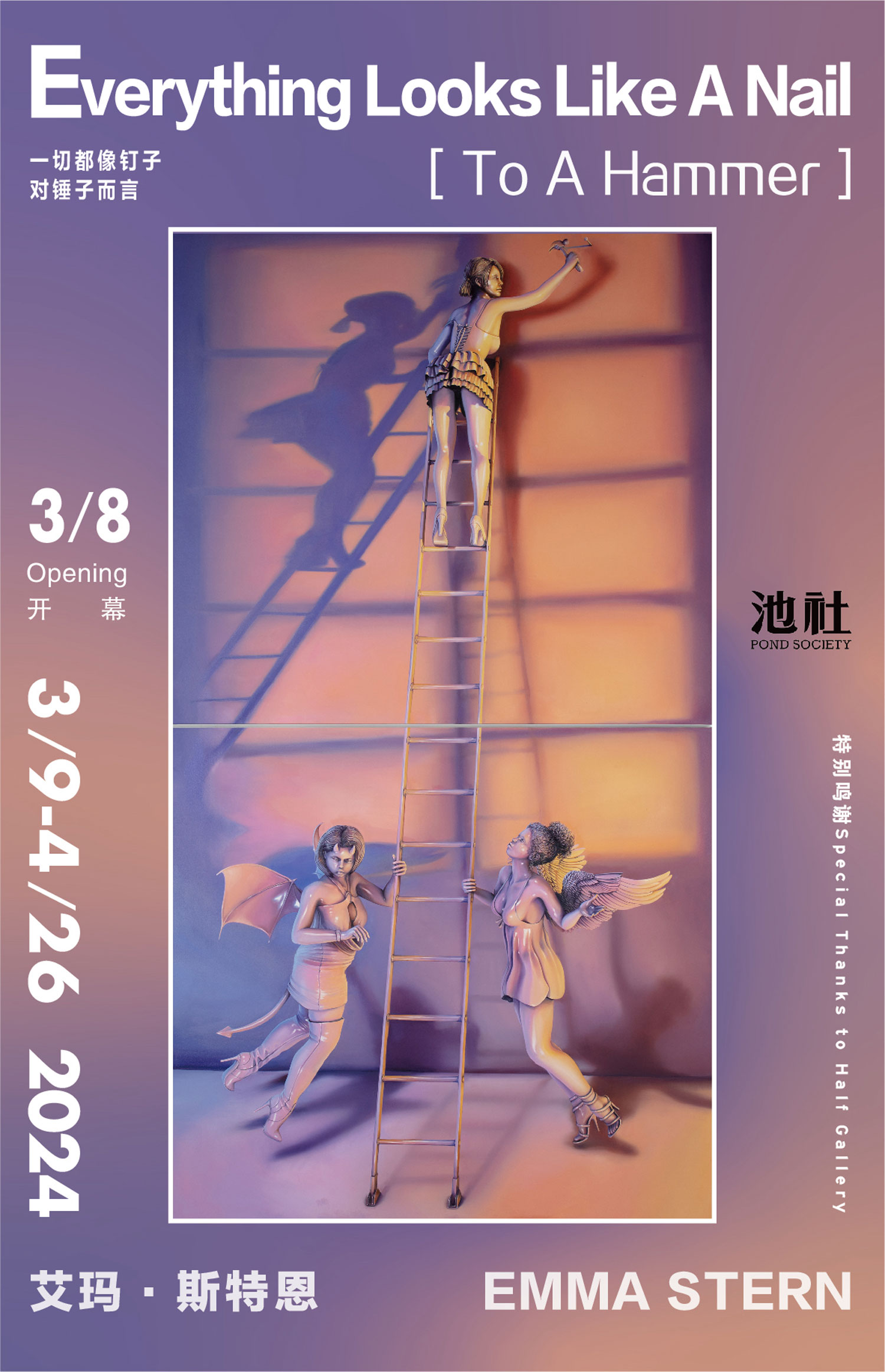展期 Period:
2024.3.8—2024.4.26
艺术家 Artist:
地点 Venue:
新闻稿 Press Release:
池社荣幸地宣布,将举办艺术家艾玛·斯特恩(Emma Stern)的个展: 一切都像钉子(对锤子而言)。
已故艺术评论家哈罗德·罗森伯格(Harold Rosenberg)认为,重要的是要记住艺术世界是一出喜剧。没有人比艺术家艾玛·斯特恩更能理解这一点。她对自己的优缺点有着清晰的认知--并将自己的才华与履历 相对应。你可能会在她工作室里看到她穿着印有“我父母认为我在学习”标语的T恤,但这并不意味着她的作品没有被迈阿密鲁贝尔博物馆永久收藏。斯特恩说:"我认为我的画可以被认为是有趣的,因为它们有一种自我意识,这使它们变得脆弱。有时,当事情让人感到不舒服时,它们会让我们发笑。不适也可以是一种幽默。”
无论是骑着摩托艇的海盗,还是在孤独的公路上驰骋的女牛仔,艾玛·斯特恩都会带着她画中坚韧、性感、充满力量的人物上路。这些作品的夸张演绎使它们更贴近隐藏在作品中的幽默感。“而且,不要误以为剑、电锯或双节棍的频繁出现是在指代肢体攻击。”斯特恩解释说,“我不觉得我的作品特别暴力。我的作品中有很多武器,但在我看来它们总是很松弛,没有危险性。也许这就是我处理暴力概念的方式,把它变得完全虚弱无力。”
我们的未来会怎样呢?我们希望艺术家们可以是先知。无论是弗朗西斯·毕卡比亚(Francis Picabia)的透明系列被视作原版 Photoshop 图像的解读,还是沃霍尔(Warhol)预言我们对成名的文化痴迷,抑或是 理查德-普林斯(Richard Prince)的 “Gangs ”作为谷歌图片结果页面的参考,我们都喜欢艺术家扮演 未卜先知的角色。阿尔伯特·奥伦(Albert Oehlen)在20世纪90年代初使用德州仪器公司的软件进行电脑绘画。从照相机的快门速度到丙烯画的出现,技术一直影响着创作成果。20世纪80年代,几乎是对于安迪·沃霍尔(Andy Warhol)丝网印刷术的回应,让·米歇尔·巴斯奎特(Jean-Michel Basquiat)在他的画布上采用了彩色复印这种新颖的连环画形式。最近,三维渲染技术的发展成为许多当代艺术家:如艾弗里·辛格(Avery Singer)和迈克·李(Mike Lee)的一种绘画手段,而艾玛·斯特恩也巧妙地利用 了这一技术,使她的绘画作品更具优势。“我使用的软件主要是为游戏开发商设计角色的,”斯特恩解释道,“情色漫画界也经常使用它。”
2014年从普瑞特艺术学院毕业后,艾玛发现自己没有足够的画像模特,于是选择自己创造,这促使她发明一个自己的全新宇宙。她将其创作材料比喻为数字熔岩,因此她在Instagram上的账号名称是@lavababy。 “在社交媒体上,任何人都在宣传自己的化身,”她推断道,“这是一个被设定过的虚拟自我。如果我们现在都在这么做,那为何不把它变成艺术,不是吗?”
人们经常会评论认为艾玛·斯特恩的作品题材具有挑逗性,她认为这很有趣,因为她的画中几乎没有裸露的部分。斯特恩说:"我一直认为,我创作的人物是一种扩展的非字面意义上的自画像,所以如果有少女的形象,那就是我在那个年龄段的替身。我有那些记忆和经历,所以我会把它们做成艺术品,我从没想过这会有问题。我认为我的某一部分是一个脆弱的16岁少女,也有一部分是一个火辣的半人马女孩。”
苹果公司于2024年已经发布了Vision Pro眼镜,我们正站在一个新的现实与虚构之间的悬崖边上。这款VR眼镜可能会改变我们对现实的看法,使自然世界与人造世界之间的竞争更加公平。或许,艾玛·斯特恩的画作也能让我们窥见21世纪的未来。
作者:比尔·鲍尔斯(Bill Powers)。他是Half Gallery的创始人,曾为Gagosian、Blum & Poe 和Almine Rech画廊策划了群展。其文章曾出现在《纽约时报》、《艺术新闻》、《华尔街日报》和《名利场》。
Pond Society is pleased to present Everything Looks Like A Nail (To A Hammer), a solo exhibition of paintings by artist Emma Stern.
The late art critic Harold Rosenberg observed that it's important to remember the art world is a comedy. No one gets this better than painter Emma Stern. She knows who she is-both sides of the pros and cons aisle- and leverages her talent commensurately to her biography. You might see her at the studio donning a "my parents think I'm studying" t-shirt but that doesn't mean she's not in the permanent collection of the Rubell Museum in Miami. "I think my paintings could be considered funny because there is a self-awareness to them which makes them vulnerable," says Stern. "Sometimes when things are uncomfortable, they make us laugh. Discomfort can be hilarious."
Pirates on jet skis or cowgirls hitching down that lonely highway, Emma Stern takes her avatars on the road: Tough, sexy, and overflowing with presence. The compositions are intentionally over-the-top to the point of parody which aligns them more closely to the humor underneath. And don't mistake the prevalence of swords or chainsaws or nunchucks as condoning physical aggression. "I don't feel that my work is particularly violent," explains Stern. "There are a lot of weapons, but they always seem very flaccid to me, not dangerous. Maybe that is how I deal with the concept of violence, by making it totally impotent."
What does the future hold for us? We want our artists to be prophets. Whether it’s Francis Picabia’s transparencies reading as proto-Photoshop imagery or Warhol predicting our cultural obsession with fame or Richard Prince’s “Gangs” as forerunner to a Google image results page, we like it when painters operate as fortune tellers, too. Albert Oehlen made computer painting in the early 1990s using Texas Instruments software, for example. Technology has always impacted creative output from camera shudder speeds to the advent of acrylic. Almost in reaction to Andy Warhol’s silk-screening, Jean-Michel Basquiat embraced the novelty of color Xeroxes on his canvases as a form of serialization in the 1980s. More recently, the advancement of 3D rendering emerged as a means of drawing for many contemporary artists - Avery Singer, and Mike Lee - which Emma Stern adeptly harnesses to her pictorial advantage. “I use software that’s mostly for game developers to do character design,” explains Stern. “It also gets used a lot by the erotica community.”
After graduating from Pratt in 2014, Emma found herself without an abundance of figure models and opted to invent her own, which in turn led to an entire universe creation. Her “materials” she likened to digital lava, hence her Instagram handle @lavababy. “Anyone on social media is promoting an avatar of themselves already,” she theorizes “a hyper-curated virtual self. If we’re all doing that now anyway, might as well make it art, right?”
Often people will comment to Emma Stern about the provocative nature of her subject matter which she finds intriguing given there’s practically no nudity in her paintings whatsoever. “I’ve always said the avatars I create are a form of extended non-literal self-portraiture so if there’s images of a teen-age girl, it’s a stand-in for me at that age,” says Stern. “I have those memories and carry those experiences with me and sometimes I make art about it. I never imagined that would be problematic. There’s a part of me that still feels like a vulnerable sixteen-year-old, but then there is another part of me that feels like a hot centaur girl.”
With Apple releasing their Vision Pro goggles in 2024, we stand on the precipice of new speculative non-fiction. The headset may likely alter our perceptions of reality, leveling the playing field between what constitutes the natural world versus the manmade. Perhaps the paintings of Emma Stern can provide us just a glimpse over the horizon of what’s ahead as the 21st century advances.
Author: Bill Powers. He is the owner of Half Gallery. He has also curated group shows for Gagosian, Blum & Poe, and Almine Rech Gallery. Powers’ writing has appeared in The New York Times, ARTnews, The Wall Street Journal, and Vanity Fair.

